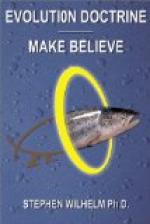organism is a collection of differentiated parts,
the organs; the life of an organism is a series of
activities of the several organic systems and organs.
If we could take away one organ after another, there
would be nothing left after the last part had been
subtracted. In a similar manner, the activities
of organs prove to be the combined activities of the
tissue-cells, and again the truth of this statement
will be clear when we imagine the result of taking
away one cell after another from organisms like the
frog or tree. When the last cell had been withdrawn,
there would be nothing left of the frog’s structure,
and there would be no element of the frog’s
life. It is true that the particular way the tissue-cells
are combined is of primary importance, but it is none
the less true that the life of a cell is the kind
of element out of which the life of even the most
complex organism is built. And we have seen that
the essential substance of a cell is a complex chemical
compound we call protoplasm, whose elements are identical
with chemical substances outside the living world.
Is there any ground for supposing that the properties
of protoplasm are due to any other causes than those
which may be found in the chemical and physical constitution
of protoplasm? In brief, is life physics and
chemistry? Nowadays the majority of biologists
believe that it is. Just as the properties of
water are contributed by the elements hydrogen and
oxygen which unite to form it, just so the marvelous
properties of protoplasm are regarded as the inevitable
derivatives of the combined properties of the various
chemical elements which constitute protoplasm.
Biologists have known for more than a century, since
the work of Lavoisier and Laplace in 1780, that the
fundamental process of the living mechanism is oxidation,
and that this process is the same, as they said, for
the burning candle and the guinea pig. Beginning
with Woehler, in 1828, scores of students of physiological
chemistry have duplicated the chemical processes of
living matter, which were regarded as so peculiar to
the living organism that they seemed to be due to
the operation of a non-mechanical and vital cause.
The investigator mentioned was the first to construct
artificially from inorganic substances the nitrogen-containing
ash product of the living organism called urea.
Now hundreds of so-called organic compounds have been
made synthetically and their number is added to week
after week. Therefore, the biologist who finds
that a physical and chemical analysis of some vital
processes is possible, and that the analysis is being
extended with astonishing rapidity, finds himself unable
to regard protoplasmic activity as anything different
in kind or category from the processes of physics
and chemistry which go on in the world of dead things.




